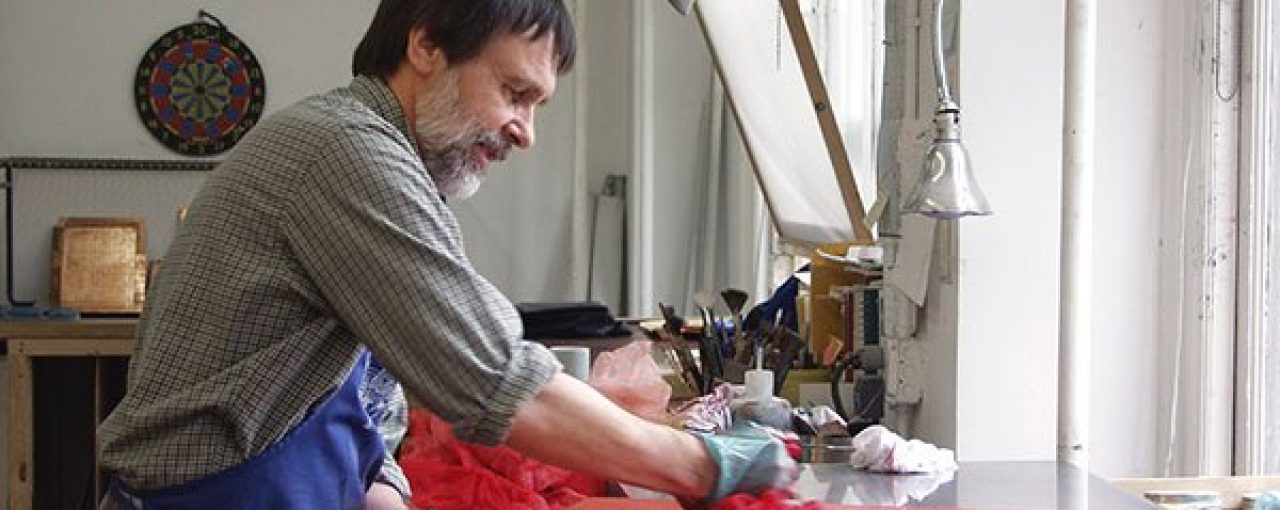Artmaking, and the Curatorial Process
Interview by Emilia Dubicki, WTP Art Correspondent
 WTP art correspondent Emilia Dubicki interviews Bill Hall and Rebecca Michelman to gain insight into Hall’s art-making and Michelman’s curatorial process, and how the two crossed paths. Hall was included in Print Facets: Five Centuries of Printmaking and Enchanted Landscapes, two print exhibits curated by Michelman at The Curator Gallery. His work is featured in the March issue of The Woven Tale Press.
WTP art correspondent Emilia Dubicki interviews Bill Hall and Rebecca Michelman to gain insight into Hall’s art-making and Michelman’s curatorial process, and how the two crossed paths. Hall was included in Print Facets: Five Centuries of Printmaking and Enchanted Landscapes, two print exhibits curated by Michelman at The Curator Gallery. His work is featured in the March issue of The Woven Tale Press.
Bill Hall was born and raised in Alabama, and earned his BFA degree from the University of Alabama, and MFA from the University of Texas in Austin. In 1982, Hall moved to New York and began his career as a collaborating printer for Robert Blackburn at The Printmaking Workshop. Four years later, he established his own print studio, NYLE Press, then joined Pace Prints in 1988. As master intaglio printer at Pace for twenty-seven years, he collaborated on several hundred editions with noted artists, including Helen Frankenthaler, Jim Dine, Mary Heilmann, Robert Mangold, Chuck Close, and James Turrell. During the 1990s, he assisted the renowned master printer, Aldo Crommelynck, best known for his numerous collaborations with Pablo Picasso.
Rebecca Michelman joined Michelman Fine Art, private art dealers, in 2003 to focus on global client development and the vetting of Impressionist, Modern, Post-War, and Contemporary artworks for acquisition and sale. Fourteen years later, her valuations play a critical role in advising collectors and clients. Rebecca’s clients appreciate her compelling presentations and her discerning approach to closing deals. She also consults with new collectors who want curatorial advice as well as guidelines for navigating the art market and mitigating risk.
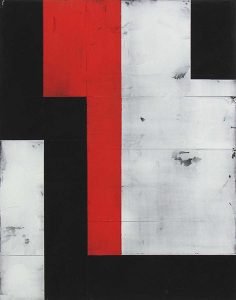
Dubicki: Rebecca, what inspires you to curate shows?
Michelman: My inspiration to curate selling exhibitions comes from a desire to tell stories about artists and their inspirations in the context of the many currents of art history. If I can do this well, I find it immensely satisfying to engage with living artists and collectors.
Dubicki: Are you drawn to certain types of artwork? Do you look at artwork and envision putting a show together?
Michelman: As a private art dealer specializing in late nineteenth- and twentieth-century art, my gaze has been distinctly focused on the past. I had never thought about curating an exhibition with living artists. Then one random day in 2013, I happened to be seated next to Ann Moore (The Curator Gallery founder) at a luncheon. With her own brand of conviction, charm, exuberance, and wit, she told me that she was thinking of launching a gallery in Chelsea to make the art market more accessible to mid-career artists and new collectors. Her vision inspired me to commit to a show and delve into the complex, undervalued, and generally misunderstood world of prints. The result was Print Facets: Five Centuries of Printmaking, a lively visual dialogue between past and present. The eclectic mix of works in this show were culled from sixty contemporary artists—age twenty-eight to ninety-eight—and thirty Masterworks from the sixteenth to twenty-first centuries hanging side by side in stimulating juxtapositions.
Dubicki: Did you know of Bill Hall’s work, and what sort of response does his work illicit from you?
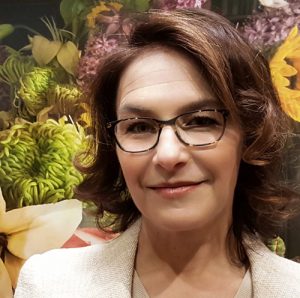
Michelman: For research, I visited master printers, the consummate professionals who interpret the visions of other artists, and discovered treasures from their personal collections. On a visit to Bill Hall, master printer at Pace Prints, I found a trove of substantive mature work influenced by the great Abstract Expressionists, and the artist was Bill himself. For the past two decades, he quietly created sublime works on weekends and vacations, while working with other artists by day for Pace. Bill cites the role of history in his work, but in the context of form: “I often make etchings on the scratched up backs of discarded copper plates. That ‘used’ history adds a human element to what otherwise would be a sterile composition.”
His series, Homage to B.N. and other works exhibited for the first time, were juxtaposed with a rare Barnett Newman print from a private collection. Newman was an artist deeply affected by personal loss and the transcendent qualities of the spiritual. I could feel this influence palpably in Bill’s work, with his own innovative and compelling results. I’ve often thought that a successful work of art relates to the viewer on a number of levels—aesthetically, intellectually, and emotionally. Bill’s work achieves this benchmark.
When Ann and I first visited him at Pace, we could tell immediately that we wanted to show his art—it felt revelatory, which is a rare experience for me with contemporary art. In particular, I loved how the construction and the content of his work related. I was drawn in by the absolute solidity of the “dark” part of the composition—the rich blacks representative of a void, the negative, nihilism or death, juxtaposed with the “light” part of the composition; the random, chaotic scratches gleaned from the backs of other artists’ discarded plates. And yet the entirety of the composition felt contained, deliberate, and sublime. I could go on and on. As with all great works of art, one develops a personal dialogue with the object which continues to inspire time and again, and this has been my experience with Bill’s work. How he achieved the result from manipulating acid metal and ink is equally compelling.
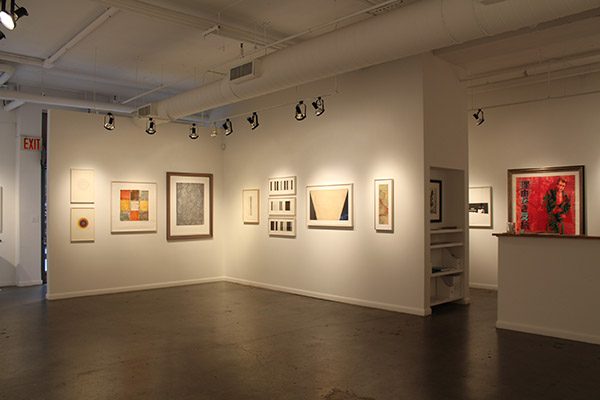
Dubicki: Bill, can you tell us a bit about your art-making process? Your work appears as if a lot of thought goes into the placement of colors and shapes, but perhaps you are more spontaneous and intuitive in your decisions?
Hall: Planned or spontaneous? It’s both. Generally, I begin by making a lot of thumbnail sketches that offer different solutions to a “problem.” For instance, when I started making the “grid” prints, it wasn’t just the idea of playing with grids, but the notion of how to make interesting images through random means. I used the throw of dice to determine which squares to blacken, moving left to right, top to bottom. From a large number of possibilities, I would select ones that were “compelling” to me in some way, and begin the plates.
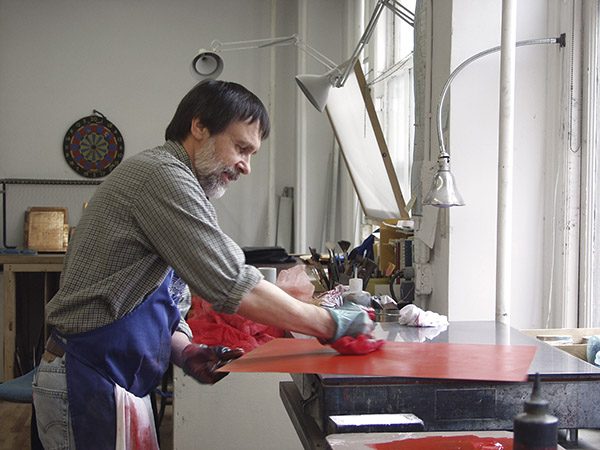
Dubicki: Your work has a nice sense of space and balance within its parameters. The subtle colors are just right. Again, intuitive or do you spend a lot of time arranging and rearranging before printing?
Hall: I think I rely on a sense of “what looks right” when deciding if something is finished or not. I don’t want the work to look too predictable or comfortable. I try to make it have an “edge” by using the tension created by contrasts—in size of elements, texture, color, etc. The original thumbnail idea stays there, but things change. One consistency is the use of the color black. I use black in both aquatints and paint to create a strong graphic quality that can be read as coming forward in the picture plane of receding into a void. This also adds a bit of mystery, with ambiguous spatial relationships.
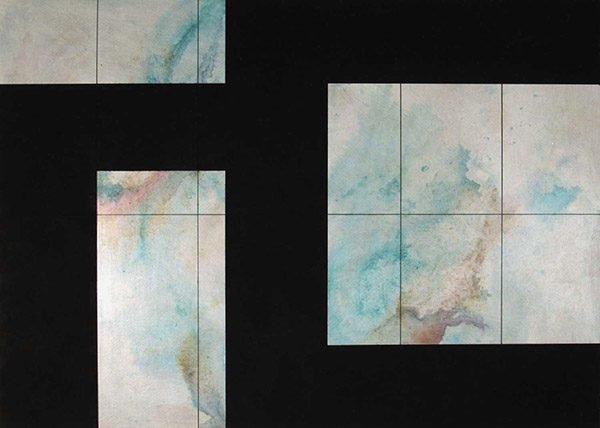
Dubicki: Can you tell us about combining painting with prints in your work?
Hall: After retirement, I decided that I didn’t want to make any more prints for a while, and even if I wanted to, I didn’t have a press. What I did have were numerous trial proofs from previous editions, which became the raw material for new work. I started cutting them up and making collages. I needed to find different ways. I had worked before selectively adding washes of acrylic color to proofs, essentially making them monoprints. Other artists who had done it—Jim Dine especially. Away from the print shop, I started adding them more, perhaps in defiance of traditional etching. Painting on prints may have been the spark. There was always in the back of my mind a desire to paint again. I hadn’t done any really since graduate school, but it felt good. I plan to make more prints and to continue painting.
Dubicki: What was it like working with Rebecca Michelman?
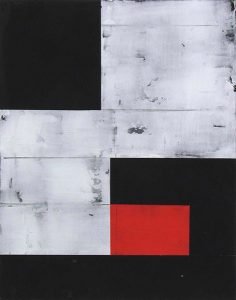
Hall: It was a pleasure working with Rebecca. She has a good eye.
Dubicki: Curating successful group shows, as you have, Rebecca, requires intuition and vision to make the diverse artwork coalesce and create a dialogue on the gallery walls. Can you discuss your concepts for shows and how exactly you conceived the curation for Print Facets: Five Centuries of Printmaking—unique in its scope as a retrospective?
Michelman: Curating a successful group show is challenging and requires good editing and story-telling skills to make it cohere. I spent months looking at many artists and prints to discover complementary or relational influences, themes, and techniques. At night when I lay down with my children as they fell asleep, I had intense meditations about the artworks, visualizing the walls of the gallery, the potential juxtapositions and the flow of the exhibition. We experimented with chronological vs. thematic storytelling and ultimately settled on aesthetic and art historical juxtapositions, which seemed the most dynamic. It was a lot of work, but it was exciting to see people react to the work of living artists hanging side by side with Rembrandt, Hopper, Picasso, and Warhol. One of the unforeseen reactions was that great works of art do not have to cost a fortune. Every artist in that show was remarkable for his or her devotion to a highly specialized, technically challenging craft.
Dubicki: How did the second print show, Enchanted Landscapes, come about?
Michelman: The inspiration for the second print show I curated for Ann, was generated by a revelation I had from the first show. The German Romantic printmakers of the late eighteenth and early nineteenth centuries are little known yet hugely important in the flow of ideas leading to Modern Art. They were among the first artists to sketch en plein air, basing their art on the direct observation of nature—which, in their endeavors, meant etching on plates. The Philadelphia Museum of Art and The British Museum in London had done very good shows on the subject, and I wanted to focus in on landscape and again juxtapose work with living artists exploring the same theme.
German Romantic printmakers such as Carl Wilhelm Kolbe (1757–1835) and Johann Christian Reinhart (1761–1847) were working during an intense period of political, cultural, and economic change; they responded with landscape scenes intended to stimulate spiritual inspiration in the viewer. Caspar David Friedrich (1774–1840), perhaps the most famous of the German Romantics, advised the artist to, “…close your bodily eye, so that you may see your picture first with the spiritual eye. Then bring to the light of day that which you have seen in the darkness so that it may react upon others from the outside inwards.”[1]
Dubicki: Are there other shows you have curated?
Michelman: In 2014 at the Print Facets opening, a woman approached me about her artwork, which has happened many times, of course. I told her I would be happy to look at it and sometime later, we had a candid conversation about her ideas and her painting and photography. I thought she had potential to evolve and gave her some ideas. A year later, she came back to me and I was amazed to see how much she had grown as an artist. This woman was Gay Gaddis, a one-of-a-kind creative force who transformed herself from successful business entrepreneur to a landscape painter of her native Texas terrain. She painted continuously for another year working exclusively outside in the driving rain, wind, scorching sun, or under the moonlit sky, all the while donning knee-high boots to protect herself from rattlesnake bites. The result was a 2016 solo show exploring the changing weather in the Texas Hills called Sky Descending: Texas Landscapes by Gay Gaddis.
Dubicki: Bill, has the change in your geographical location, moving from New York, changed your work? Are you inspired by your environment?
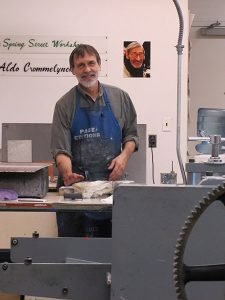
Hall: Moving to Asheville, North Carolina, has been a great change, but along with it came my retirement, so it’s hard to separate the two. I like them both. The beauty here in the mountains is inspirational, but that hasn’t had much effect on the work itself, that I’m aware of. Having time to work, and in a more peaceful place, has had the biggest effect. There is a lot of excellent craft work here, but I do miss the painting shows in New York.
Dubicki: How was the transition from being a master printer of other artists’ work to now being master printer of only your own work? Are you spending more time in the studio now?
Hall: I’ve been developing different work habits, now that I am not constrained by a day job. It is nice to be able to work in the mornings now when I’m more alert. How has the transition been? The value of my experience working with other artists can’t be overstated. I was able to see so many very smart and creative people at work—to see the way they approached problem solving and made their art. I’m sure that I have taken a lot of that with me. As much as I value that experience, making my own art feels very good. I no longer have to focus on the fine details of producing other artist’s prints. Much of the stress is gone. If I scratch a plate now, it is my plate. Now, it’s just me that I have to satisfy.
Dubicki: Do you like studio visitors?
Hall: My studio is at home and I haven’t had many visitors. I wouldn’t mind, though.
Dubicki: I see a road trip in my future.
[1] The Romantic Imagination: Literature and Art in England and Germany (1996) by Frederick Burwick and Jürgen Klein.
Copyright 2018 Woven Tale Press LLC. All Rights Reserved.

